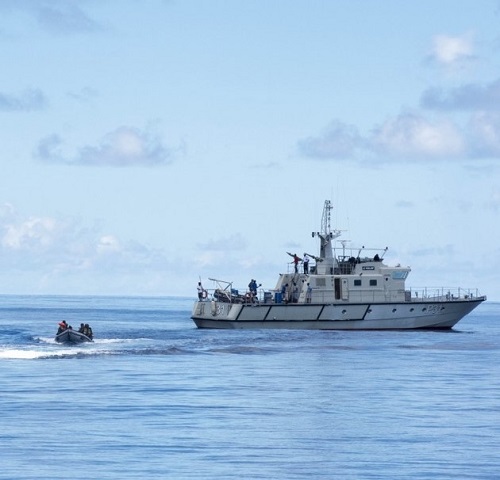We are still trying to figure out a lot of things in terms of threats, vulnerabilities and the integration of resources. We need to ensure that the satellite realm is recognized as critical infrastructure.
Satellite is a technology, which plays a critical role already, but most often omitted from formal discussions, and this is a huge problem.
Satellite communications is rarely mentioned as a specific solution or recommendation that spells out the need for improved communications and interoperability. There are instances, however, where attention is focused on a possible satellite solution such as border, port and maritime security. Recall the long-range vessel tracking system. In this case, we develop and implement a long-range automatic vessel tracking system for all vessels in Nigeria waters that are equipped with the Global Maritime Distress and Safety System or equivalent satellite technology. The system shall be designed to provide the safety agencies or the authority the capability of receiving information on vessel positions at interval positions appropriate to deter transportation security incidents.
The above underscores the pivotal role of satellite technology at sea, and offers a possible way to solve the vessel tracking puzzle, which is an important dimension of port and maritime security under a much broader concept known as maritime Domain Awareness [MDA] as well as the system known as the Universal Shipborne Automated Identification System [AIS].
SECURING CARGO AND PORTS:
- The goal here is to increase security throughout the entire international logistics chain by implementing security verification techniques. Building security into the global supply chain is a huge challenge.
- By expanding the role of satellite based systems such as GPS, AIS and the vessel Monitoring system, we can reinforce and extend our existing security verification techniques. Satellite technology is essential to making key elements of overall MDA system work.
- AIS a top priority which has been kicked into high gear by MDA. As a GPS-based system, AIS does include a possible long range interface with a satellite feed, for example.
The International Maritime Organization [IMO] is speeding up required carriage of AIS as well.
We have to have sufficient transparency and be able to verify low risk cargo as we go about building more confidence into our maritime and port security apparatus in general.
The process of tracking cargo as it moves along throughout complex intermodal transportation system mandates that we move our borders out, and provide security that moves with the box or container in question.
- Although satellite enjoys general recognition in terms of the key role it can play here, satellite is not going to happen without real advocacy. A good paper trial has to be wrapped around a regulatory model to drive more innovations in the maritime domain. This will enable the exploration of new technology such as electronic seals, vessel tracking and electronic notification of vessel arrivals.
- There is a growing interest in the use of satellites and GPS and global location systems to track the movement of cargo in real time. We are aware several companies have piloted advanced devices such as transponders and electronic seals, which when used with satellite technology, can pinpoint the location of a truck chassis, container, truck, ship or railcar in real time.
While the results of these demonstrations have been promising, we have also seen that this technology is feasible in a complex, commercial supply chain, on a practical as well as on an economic level.
Testing of satellite technology also upholds the devices for their ability to withstand the rigors of the commercial sea container/port environment, the effectiveness of the communication infrastructure, and their scalability, with the goal of developing requirements and protocols that can be commercialized within a competitive marketplace.
- While satellite technology is able to assist maritime security, primarily in terms of tracking ships or cargo consignments, resources could be a problem.
Again, it would be inordinately expensive to track everything, and would create a blockage nightmare as well.
However, if some sort of compromise over the level of blockage can be achieved, there is much promise in satellite technology.
- Remember, success will be very much reduced if some sort of tracking is not introduced for at least suspect vessels. So satellites would help very much, but again, depending upon the resources available. The Coast Guard [as the only resource] will certainly be stretched to do this vessel tracking job in a thorough manner.
BORDER PATROL LINKED VIA SATELLITE:
As for the nation’s borders, and the role of satellite technology in such programs as Smart Border Initiative, the National Transportation Security Plan and the National Land Border Security Plan, the door remains wide open. This is because for the large states, Cellular Digital Packet Data [CDPD] or Radio Frequency [RF] is not viable options.
- Therefore, we need the applications of satellite for data transfer. We can implement a limited number of satellite voice units to supplement regular radios in fringe coverage areas.
Absolutely, the recommendation is that the federal Government should spend more money to equip state law enforcement agencies in rural Border States with more satellite equipment [linked to NigComSat-1R] both for routine use as well as for enhanced border security purposes. Note that the border is one of the areas where we have the weakest coverage utilizing our existing radio technology. Hence any activity we participate with in those areas should see the benefit of satellite technology regardless of whether it is border security, search & Rescue or our other law enforcement missions.
- In every state, we can start with two vans assigned to perform commercial vehicle enforcement tasks equipped with two-way satellite terminals that can be used for dispatch as well as to instantaneously access driver and vehicle data anywhere in the state, including its remote border region. With the satellite technology, one can quickly check all the paperwork, validate the driver and verify that any Department of Transportation permits are valid, if required. One goal here is to simply increase monitoring presence in this remote and scarcely populated region both for safety and security purposes. The cost and ease of use of satellite gear are important considerations as well. There is no question that commercial vehicle enforcement activities represent a critical part of the overall plan to enhance border protection.
SATELLITE IMAGERY CONTROL:
- Besides making sure that satellite technology is used in the most effective way to protect borders, coasts, and port, government and military officials must also ensure that any group seeking to do harm does not gain access to high-resolution satellite imagery.
- We need policies for prohibiting the release of imagery beyond a certain resolution such as the guidelines provided by the appropriate security department, notification when an image crosses an international boundary, or when such a request is made by a person or group.
There is thus, a great need for effective and efficient schemes for facilitating such controlled dissemination of satellite imagery and the information products generated from it.
- Experts in the area of information systems security have access control model for high-resolution satellite image databases.
Commercial Satellite Organizations should proactively address sensitive satellite-related issues such as the fact that image collection or distribution must be constrained where there is an immediate and substantial threat to national security or foreign policy commitment.
FUTURE SOLUTIONS VIA SATELLITE:
Reliable and affordable satellite solutions are reliable and most can be quickly obtained as off the shell, commercial satellite products.
Enhancing border, port and maritime security may require the creation of novel hybrid solutions which can be useful to multiple agencies. Using the broad footprint of satellites, along with the proven reliability of satellite-based solutions can be brought to bear quickly on a variety of security-related objectives.
Source: Commweek










